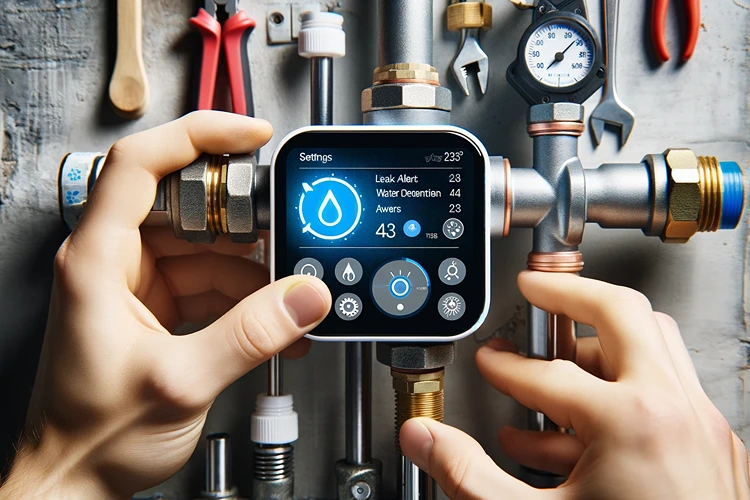Integrating Leak Detection Systems in Home Construction

Imagine a world where every home is shielded from the unseen threat of water leaks, where the integrity of buildings is preserved, and homeowners enjoy peace of mind. This is the reality that integrating leak detection systems in home construction promises.
It’s a smart, proactive approach to safeguarding homes against the potential devastation caused by undetected water leaks. This article explores the transformative power of these systems, offering an in-depth look at how they’re changing the landscape of home building and maintenance.
The Role of Leak Detection Systems
At their core, leak detection systems serve as an early warning mechanism, identifying leaks that, if left unchecked, could lead to significant damage. These systems use advanced technology to monitor water flow and pressure, detecting anomalies that indicate leaks. They range from simple sensor-based alarms to complex networks that can automatically shut off water supply, minimizing damage and conserving water.
Helpful Hint:
For optimal protection, choose a system that offers real-time water usage monitoring. This feature can help identify slow leaks that might not trigger immediate alarms but can cause long-term damage and waste.
Integrating Leak Detection: The Why and How
Integrating leak detection systems during the construction phase of a home brings numerous benefits. It allows for strategic placement of sensors in high-risk areas, such as bathrooms, kitchens, and laundry rooms, ensuring comprehensive coverage. Moreover, it facilitates seamless aesthetic integration, preserving the home’s design while embedding crucial protection mechanisms.
Types of Leak Detection Systems
Leak detection technology can be categorized into two main types: passive and active systems. Passive systems alert homeowners to the presence of a leak, typically through an audible alarm. Active systems, on the other hand, not only detect leaks but also take immediate action by shutting off the water supply to prevent further damage.
Best Practices for Installation
Effective installation of leak detection systems requires careful planning and execution. This includes selecting appropriate sensors, determining their optimal placement, and integrating them with the home’s plumbing and electrical systems.
Working closely with experienced professionals ensures that the system’s installation enhances the home’s safety without compromising its design.
Stats:
Research indicates that homes with actively monitored leak detection systems are up to 5 times less likely to suffer major water damage compared to homes without such systems.
Smart Home Integration: Elevating Leak Detection
The advent of smart home technology has significantly enhanced the capabilities of leak detection systems. By integrating these systems with home automation platforms, homeowners can receive instant alerts on their smartphones or other devices, allowing them to respond swiftly to leaks, even when they’re away from home.
Environmental and Economic Impacts
Leak detection systems not only protect homes but also have a profound environmental impact. By preventing leaks and promoting efficient water use, they contribute to water conservation efforts, which is critical in areas facing water scarcity.
Economically, the savings on water bills and avoided repair costs make leak detection systems a wise investment for any homeowner.
Regulatory Considerations and Industry Standards
As leak detection technology becomes increasingly integrated into home construction, understanding regulatory requirements and industry standards is essential. These regulations can vary by region but often include specifications for system installation, performance, and maintenance to ensure they provide reliable protection against leaks.
Future Trends in Leak Detection Technology
The future of leak detection in home construction is bright, with ongoing advancements in sensor technology, artificial intelligence, and machine learning enhancing the accuracy and responsiveness of these systems. Future trends may include predictive maintenance capabilities, where systems can forecast potential issues before they lead to leaks.
Choosing a Leak Detection System
Selecting the right leak detection system involves considering factors such as the system’s sensitivity, connectivity options, compatibility with smart home devices, and the level of protection it offers. It’s also important to evaluate the system’s ease of use and the quality of customer support provided by the manufacturer.
Maintenance and Upkeep: Ensuring Long-Term Reliability

Regular maintenance is key to ensuring the long-term reliability and effectiveness of leak detection systems. This section covers routine checks, sensor calibration, battery replacement, and other maintenance tasks that homeowners should perform or schedule with professionals.
FAQs
Bottom Line
The integration of leak detection systems in home construction marks a significant advancement in home safety and efficiency. These systems not only prevent costly damage and conserve water but also exemplify the shift towards smarter, more resilient homes. By choosing the right system, homeowners can protect their investments, contribute to environmental conservation, and enjoy greater peace of mind.
Additional Resources:
- Environmental Protection Agency (EPA) WaterSense: www.epa.gov/watersense – The EPA’s WaterSense program offers resources on water-efficient products and practices, including technologies like leak detection systems that can help homeowners save water and money.
- International Association of Plumbing and Mechanical Officials (IAPMO): www.iapmo.org – IAPMO develops plumbing and mechanical codes used in the construction of residential and commercial buildings. Their resources can help understand the standards and regulations applicable to leak detection systems.
- HomeAdvisor Water Leak Detection: www.homeadvisor.com – This site connects homeowners with local service professionals to install, maintain, or repair leak detection systems, offering quotes and expert advice on home improvement projects.


